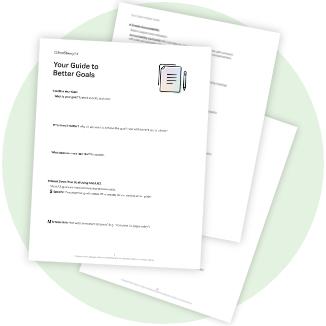How to Set and Achieve Goals Using CliftonStrengths
The best goals combine outcomes you want with your natural ability to achieve them. Pursue strengths-based goals by understanding and leveraging your natural talents, habits and motivations.
01. What Is a Strengths-Based Goal?
A strengths-based goal draws on your natural talents to make positive and lasting change in your life while challenging you to use your talents in new ways. At a minimum, set these goals with your top five CliftonStrengths in mind. If you don't know yours, check out the assessment.
A brief example of a strengths-based goal might look like this:

Why is it important to set goals with your strengths in mind?
Because far too often, we set goals that are intended to punish ourselves for "poor" behavior, for a talent we don't have or for an accomplishment we haven't achieved.
Strengths-based goals offer a new approach -- one that allows you to look realistically at:

What's important to you

How you want to grow

What changes you'll make
This approach helps you set personal goals that stretch you, that are exciting and that complement your natural talents.

Download the Goal-Setting Worksheet
Use this goal-setting worksheet to set better goals, and then use your strengths to achieve them.
02. Smart Goal Setting Begins With a Solid Approach
Step 1: Define Your Goal
Start by clarifying exactly what you want to achieve. A specific goal gives you a clear direction and keeps you focused on the end result. Consider why this goal matters and how it will benefit you or others.
Step 2: Break Down Your Goal Using S.M.A.R.T.
The S.M.A.R.T. framework is designed to make goals achievable and measurable. Ask yourself:
Specific: What exactly do you want to accomplish?
Measurable: How will you measure progress?
Achievable: Is this goal realistic given your resources and time?
Relevant: How does this goal align with your values and priorities?
Time-bound: What is your deadline?
Step 3: Actionable Steps
Achieving your goal should feel possible when broken down into smaller, manageable steps. Identify key actions that will help you achieve your goal, and consider how your unique strengths can support these efforts.
Step 4: Identify Potential Obstacles and Solutions
No goal is without its challenges. Think ahead about potential distractions or difficulties, and use your strengths to strategize solutions. Being prepared will help you stay on track even when things get tough.
Step 5: Create Accountability
Accountability is key to staying on course. Find someone -- like a friend, coach or colleague -- to help keep you motivated and track your progress. Celebrating milestones, big or small, will help you maintain momentum.
Step 6: Visualize the Outcome
Visualize the feeling of success you'll have once you've achieved your goal. Imagine the changes it will bring and how it will positively impact you or others.
Remember: The best goals are ones that inspire and drive you. By incorporating strengths into your goal-setting process, you'll create a plan that feels not only achievable but also deeply motivating.

03. Set Your Goal, and Make It Actionable
Different talents and motivations play heavily into goal setting. Let's look at a S.M.A.R.T. goal example to inspire some goals to set for yourself -- and to show you how to use your strengths to achieve them. Follow the framework from the section above, and then incorporate your strengths.
Scenario:
Imagine that you're a manager. You've noticed some low engagement on your team recently -- and in speaking with your employees, you've learned that they feel like their efforts and successes aren't being recognized or celebrated. You want to fix this.
- Define Your Goal Your goal might be to increase the amount of recognition each team member receives. Start by asking yourself why this matters to you and your team. Perhaps increasing recognition will improve morale, foster a sense of accomplishment and drive better performance.
- Break Down Your Goal Using S.M.A.R.T.
-
 SpecificI want to increase the number of times I recognize each employee every month.
SpecificI want to increase the number of times I recognize each employee every month. -
 MeasurableI will recognize each team member at least three times a month. After each quarter, I'll ask employees if they feel satisfied with the recognition they're receiving.
MeasurableI will recognize each team member at least three times a month. After each quarter, I'll ask employees if they feel satisfied with the recognition they're receiving. -
 AchievableI will use reminders on my calendar to ensure I take time to acknowledge employees throughout the month, especially after completing significant tasks or milestones.
AchievableI will use reminders on my calendar to ensure I take time to acknowledge employees throughout the month, especially after completing significant tasks or milestones. -
 RelevantRecognition is important because it aligns with my values of appreciation and fostering a positive, supportive work environment.
RelevantRecognition is important because it aligns with my values of appreciation and fostering a positive, supportive work environment. -
 Time-boundI will implement this goal by the end of next month and continue on a monthly basis thereafter.
Time-boundI will implement this goal by the end of next month and continue on a monthly basis thereafter.
-
- Actionable Steps To achieve this goal, I'll schedule 10-minute discussions with my team members during one-on-one meetings to learn their preferred recognition styles. I will also create calendar reminders so I don't forget to acknowledge each person regularly. My strengths can help: I'll use my Relator theme to build genuine connections and my Activator theme to give recognition in real-time.
- Identify Potential Obstacles and Solutions I might encounter challenges, like having a busy schedule or forgetting to follow up. To overcome this, I'll rely on my Input theme to gather information about how each person likes to receive recognition and my Achiever theme to stay organized and on top of my commitments.
- Create Accountability I'll work with an accountability partner to stay motivated and check in on my progress. I'll also celebrate small wins along the way, like acknowledging when I've given consistent recognition for a week. Recognizing my own efforts will help me stay focused and energized to continue the practice.
- Visualize the Outcome I picture my team members feeling more motivated and engaged as they begin to receive regular recognition. This boost in morale will create a more connected, empowered team, driving better performance.
04. What to Do If Goal Setting Doesn't Come Easily for You
People avoid goal setting for many reasons:
- You feel overwhelmed by the progress you need to make.
- You prefer that other people set goals for you.
- You have countless ideas, but you're not sure where to start.
Many people experience roadblocks like these. That's why we've created a free, downloadable goal-setting worksheet -- to give you step-by-step guidance on your goal-setting journey.

Strengths-Based Goal-Setting Worksheet
05. More CliftonStrengths Goal-Setting Resources
Check out these resources on how to use your strengths to set and achieve your goals.

How to Set Goals at Work That Lead to Higher Performance
Learn More
Reframe Your New Year's Goal Setting by Using Your Strengths:
Learn More
Set Better Goals, Then Use Your Strengths to Achieve Them:
Learn More
